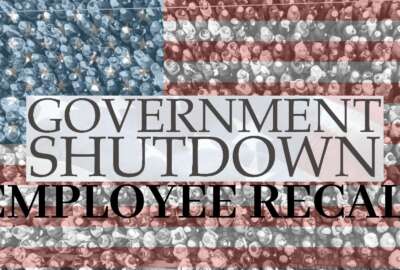
GAO looking at whether shutdown-impacted agencies exceeded authority in staying open
GAO is taking a closer look at whether some of the efforts agencies took during the last shutdown meet the criteria for very narrow exceptions under the Antidef...
Best listening experience is on Chrome, Firefox or Safari. Subscribe to Federal Drive’s daily audio interviews on Apple Podcasts or PodcastOne.
Agencies went to extraordinary lengths to keep the lights on during the 35-day partial government shutdown that ended in January. In some cases, that meant recalling thousands of previously furloughed federal employees deemed nonessential at the beginning of the lapse.
But looking back on the aftermath of the longest funding lapse in U.S. history might be useful if Congress fails to avert another shutdown before October 1st, which is exactly what some agencies are doing.
The Government Accountability Office is taking a closer look at whether some of the efforts agencies took last time meet the criteria for very narrow exceptions under the Antideficiency Act, which prevents agencies from spending any funds that Congress hasn’t appropriated yet.
Comptroller General Gene Dodaro, at a keynote address at the Association of Government Accountants, said auditors are working on more than a dozen opinions focused on whether agencies went beyond the exceptions outlined in the law.
“This year with the shutdown, a number of agencies went on long and a number of people carried out activities under the very limited exceptions that the federal agencies can operate to protect life and property during that period of time, so there are a lot of questions,” Dodaro said on July 22.
Dodaro didn’t say when GAO expects to complete those reviews. But agencies might need that guidance sooner rather than later. The House and Senate left this week for a six-week August recess, giving them about three weeks to reach an appropriations deal when they get back in September.
Here’s the work that remains: The House has marked up all 12 of its spending bills and passed 10 of them. But the Senate Appropriations Committee hasn’t yet started writing up their 12 spending bills because members waited until Congress reached a budget deal.
So with the shutdown deadline looming, agencies are looking back at what they did to keep running during the last shutdown.
Tim Soltis, deputy controller at the Office of Management and Budget also spoke at AGA’s recent conference in New Orleans, where he fielded questions about upcoming shutdown preparations. He said the administration expects Congress to act, but looking back on how the last shutdown has played out has given OMB a new perspective on how to respond the event of another shutdown.
“Really the way to think about how to plan for it, it’s like a catastrophic event. It’s a human-made catastrophic event, you’re basically a hurricane … taking down some type of capability in the government,” Soltis said, adding that shutdown preparations depend on the time of year and how many agencies are shut down.
During the last shutdown, agencies took extraordinary measures to keep going. Halfway through the shutdown, the IRS brought back more than half of its employees back to work, the Agriculture Department reopened the Farm Service Agency to help process farm loans, and the Federal Aviation Administration brought back nearly all of its aviation safety inspectors to work.
But behind the scenes, agency chief financial officers played a huge role in keeping the lights on, stretching every last dollar to keep operations going.
Lynne Moaney, USDA’s deputy CFO, speaking on a panel at the AGA conference, said the 35-day partial government shutdown presented the agency with some new challenges.
“This was not our first shutdown, so we had our shutdown plan. We dusted it off, we know we needed X-amount of people to be able to carry out the mission. We sent it in and we thought everything was going to be fine,” Moaney said. “But as the shutdown lasted longer and longer, it really started to become problematic – like, what are we doing?”
And as the shutdown dragged on, Moaney said her office kept in daily contact with USDA’s Office of General Counsel and budget director. The agency also faced unprecedented challenges, like how to keep paying out SNAP benefits during the shutdown.
Once the shutdown ended, the USDA’s National Finance Center faced a crushing workload. The NFC had about two days to process two full paycheck cycles missed during the shutdown. That meant issuing paychecks for 600,000 employees worth more than $5 billion dollars.
Moaney said NFC handled most of the backpay without any issues, but she did admit there were a few snags.
“The capacity issue kind of slowed things down a little bit, and I think we realized that, but we had teams that were there night and day … to make sure that the pay went out as quickly as possible,” she said.
Sean Mildrew, the deputy CFO at the Patent and Trademark Office, said the agency didn’t shut down because it’s fee-funded and has no year-authority for its resources. But speaking more generally, he said the last shutdown undermined one of the government’s best recruiting tools — job stability.
“That’s a plus for the government, to have that stability, and when we remove that stability or when there’s a perception that the stability is no longer there, we sort of lose our little bit of a competitive edge,” Mildrew said. “It’s sort of a trade-off for high salaries … And when those trade-offs aren’t as clear as they used to be, I worry about that as we try to retain our best talent and try to recruit future talent.”
Copyright © 2024 Federal News Network. All rights reserved. This website is not intended for users located within the European Economic Area.
Jory Heckman is a reporter at Federal News Network covering U.S. Postal Service, IRS, big data and technology issues.
Follow @jheckmanWFED





